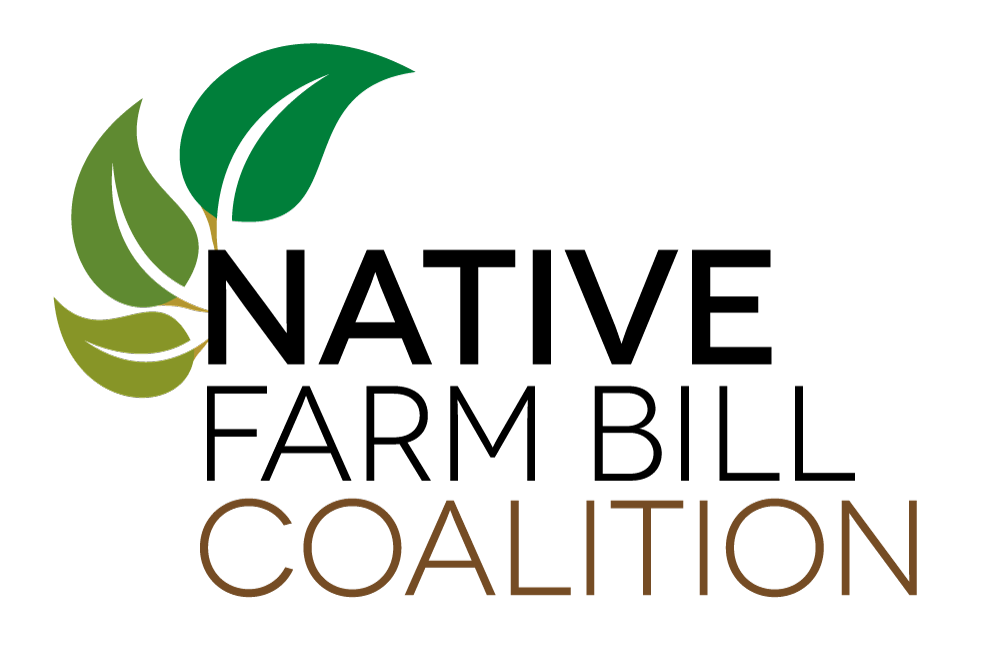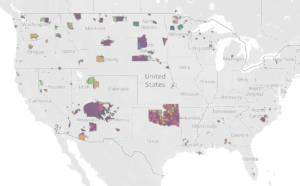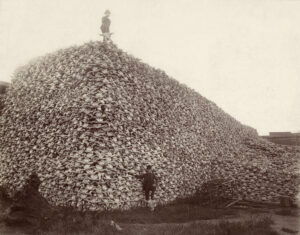By Raven McMullin
It goes without saying that the food system in the United States was created without the intent of maintaining or supporting traditional Native foodways.
In fact, more than neglecting these traditional systems, new settlers sought to destroy Native food sources and economies—forcing dependence upon a strange and commodified food chain. However, traditional foodways (what settlers intended to damage beyond repair) are being repaired and rebuilt by Native communities. Still, the United States’ food system has a long way to go in supporting these healthy Native food economies and land stewardship activities.
Federal expenditures outlined in the Farm Bill aim to supplement the work of agricultural professionals and other entities responsible for moving food from farms to tables. First enacted in 1933 and reauthorized every five years, the Farm Bill is one of the most influential pieces of legislation for agricultural and nutrition subsidies, now covering everything from livestock and horticulture to rural development and conservation.
Without a doubt, the Farm Bill has had a substantial impact on Native agriculture in the United States. Native peoples, especially Tribes, farmers, and agricultural producers, are at the forefront of the change-making, ensuring that the Bill expands opportunities for Native agriculture professionals and demands greater accountability for a safer and just food system. One key advocacy group that is forwarding indigenous concerns for the new Farm Bill is The Native Farm Bill Coalition.

For those who do not already know, the Native Farm Bill Coalition (NFBC) works with Native producers, agriculture professionals, and Tribal governments to build consensus and advocate for Native American policy priorities relating to food, conservation, and agriculture.
NFBC is a joint project of the Intertribal Agriculture Council, the Shakopee Mdewakanton Sioux Community, the National Congress of American Indians, and the Indigenous Food and Agriculture Initiative. Today, there are more than 170 Tribes, Intertribal groups, Native organizations, and non-Native allies that have become members of the NFBC since its launch in October 2017. To learn more about the Coalition, visit their website at nativefarmbill.com!
In this blog post, we will highlight key provisions in the Farm Bill articulated by the NFBC’s 2023 policy priorities report. We will also discuss how the data hosted on our website can help inform these Tribal priorities and opportunities in the Farm Bill.
NFBC's Gaining Ground Report

In all cases, potential changes identified [in the policy priorities brief] would enhance Tribal Nations’ and Native producers’ access to important USDA programs and authorities that build communities, create jobs, grow economies, feed people, safeguard natural resources, and prioritize Tribal sovereignty.
"Gaining Ground," NFBC Policy Priorities Report by Erin Parker, Carly Griffith Hotvedt, et al. with the Indigenous Food and Agriculture Initiative.
The 134-page ‘Gaining Ground’ report details priorities for enhancing and protecting Native agriculture in 12 different titles: commodities, conservation, trade, nutrition, credit, rural development, research, forestry, energy, horticulture, crop insurance, and miscellaneous items. NFBC writes, “‘Gaining Ground’ identifies potential opportunities to build on the progress made in 2018 to ensure Indian Country’s unique needs are met in each of the Farm Bill’s titles.” For greater ease of reading, the Native Farm Bill coalition has also published short summaries of opportunities within each title.
In this new era of the Farm Bill, we believe that the Native Land Information System (NLIS) can assist Tribes in the assessment and protection of their resources. In the next section below, we highlight a few NFBC opportunities listed for the commodities, conservation, credit, forestry, and miscellaneous titles and cater specific data resources to each title area. For purposes of this blog post, the opportunities highlighted in each of the NFBC’s title summaries are NOT exhaustive, as we only emphasize a few key opportunities that the NLIS can help inform. For a full summary of all potential opportunities within each title from the NFBC, please visit the Native Farm Bill Coalition website.
Title I: Commodities
Here are a few potential opportunities listed in the Commodities title summary:
- Expanding Tribal access to the Livestock Forage Disaster Loss Program.
- Expanding Native membership in the Farm Service Agency (FSA) County Committee. This opportunity requires the FSA to use Census data and Census of Agriculture data to assess county populations to ensure that Tribal members are “effectively and efficiently notified of county committee nomination opportunities” (NFBC).
- Expanding eligibility for tribal producers to have 80-90% of the cost covered for tree replacement, salvage, pruning, and removal. This would also include the costs of preparing lands for tree restoration on tribal lands. Tribal producers would also become recognized as “legal entities” and “persons” allowed to participate in the program.
NLIS Resources:
Here are some quick links to data resources relating to these opportunities:
Drought Monitor on US Native Lands
USDA Census of Agriculture for American Indian Reservations Dashboard
Soil Capability on US Native Lands Dashboard
Title II: Conservation
Here are some potential opportunities listed in the Conservation title summary:
- Increasing recognition of TEK conservation practices for Tribes in conservation programs.
- Enhancing Natural Resources Conservation Service (NCRS) Programming for Tribal producers.
- Amending the Priority Resource Concern’s definition to include Tribally-identified resource priorities. NFBC writes that this opportunity would provide greater tribal inclusion and facilitate NRCS funding to address more Tribally-driven concerns.
- Ensuring that conservation activities are compliant with a Tribal government’s Agricultural Resource Management Plan (ARMP) if a Tribe has completed one.
- Creating a permanent fund within the available technical assistance funding authorities, appropriations, and programs “to ensure that Tribal governments, Tribal organizations, and Tribal landowners and producers throughout Indian Country-including in all Tribal areas of Alaska and Hawaii-have specialized technical assistance available on a continual basis.”
NLIS Conservation Resources:
Here are a couple data resources related to opportunities in the conservation title:
Preserving Intact Habitat on US Native Lands Storymap
ARMP-IRMP Planning Portal
Title V: Credit
Included in this title summary are proposed provisions for expanding credit access to Tribal producers to support Native food economies. One provision in particular that we highlight is:
- Requiring the Farm Credit System to expand loan access to Native Agricultural producers. Along with this, the Farm Credit System would be required to implement programs designed to increase credit access to Native agricultural producers and Tribes.
NLIS Credit Resources:
Our USDA Census of Agriculture Dashboard is a data resource that could help inform the opportunities listed in the Credit title:
USDA Census of Agriculture for American Indian Reservations Dashboard
Title VIII: Forestry
NFBC begins this title summary with the recognition that nearly 300 Tribes and Bands care for forest lands. Some potential opportunities include:
- Supporting greater Tribal participation in Tribal Forest Protection Act (TFPA) projects by applying 638 Contracting Authority to TFPA projects on Forest Service or BLM lands
- Creating permanent funding through the 638 Authority for these projects/contracts (NFBC writes that no funding for this purpose was allocated in the 2018 Farm Bill, so USFS is limited by available funding at the individual National Forest level).
NLIS Forestry Resources:
Here are a few resources related to opportunities listed in the Forestry title:
Land Covers & Land Cover Change on US Native Lands Dashboard
National Land Cover Database: Tribal Lands Viewer
Thermal Activity on US Native Lands
Title XII: Miscellaneous
One of the opportunities listed in this title summary includes:
- Requiring greater coordination between the BIA and the USDA to support Tribal decision-making and implementation of Tribal ARMPs.
NLIS Resources:
Our ARMP-IRMP Planning Portal is a potential resource to help with enhanced coordination and decision-making of Tribal ARMPs:












